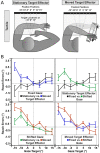Towards explaining spatial touch perception: Weighted integration of multiple location codes
- PMID: 27327353
- PMCID: PMC4975087
- DOI: 10.1080/02643294.2016.1168791
Towards explaining spatial touch perception: Weighted integration of multiple location codes
Abstract
Touch is bound to the skin - that is, to the boundaries of the body. Yet, the activity of neurons in primary somatosensory cortex just mirrors the spatial distribution of the sensors across the skin. To determine the location of a tactile stimulus on the body, the body's spatial layout must be considered. Moreover, to relate touch to the external world, body posture has to be evaluated. In this review, we argue that posture is incorporated, by default, for any tactile stimulus. However, the relevance of the external location and, thus, its expression in behaviour, depends on various sensory and cognitive factors. Together, these factors imply that an external representation of touch dominates over the skin-based, anatomical when our focus is on the world rather than on our own body. We conclude that touch localization is a reconstructive process that is adjusted to the context while maintaining all available spatial information.
Keywords: Tactile; body posture; localization; multisensory; reference frames.
Figures




Similar articles
-
Concurrent use of somatotopic and external reference frames in a tactile mislocalization task.Brain Cogn. 2017 Feb;111:25-33. doi: 10.1016/j.bandc.2016.10.005. Epub 2016 Nov 2. Brain Cogn. 2017. PMID: 27816777
-
Flexibly weighted integration of tactile reference frames.Neuropsychologia. 2015 Apr;70:367-74. doi: 10.1016/j.neuropsychologia.2014.10.001. Epub 2014 Oct 19. Neuropsychologia. 2015. PMID: 25447059
-
Multiple spatial representations determine touch localization on the fingers.J Exp Psychol Hum Percept Perform. 2014 Apr;40(2):784-801. doi: 10.1037/a0034690. Epub 2013 Dec 23. J Exp Psychol Hum Percept Perform. 2014. PMID: 24364704
-
The representation of space near the body through touch and vision.Neuropsychologia. 2010 Feb;48(3):782-95. doi: 10.1016/j.neuropsychologia.2009.10.010. Epub 2009 Oct 26. Neuropsychologia. 2010. PMID: 19837101 Review.
-
From maps to form to space: touch and the body schema.Neuropsychologia. 2010 Feb;48(3):645-54. doi: 10.1016/j.neuropsychologia.2009.08.017. Epub 2009 Aug 20. Neuropsychologia. 2010. PMID: 19699214 Free PMC article. Review.
Cited by
-
External location of touch is constructed post-hoc based on limb choice.Elife. 2020 Sep 18;9:e57804. doi: 10.7554/eLife.57804. Elife. 2020. PMID: 32945257 Free PMC article.
-
Brain-machine interface learning is facilitated by specific patterning of distributed cortical feedback.Sci Adv. 2023 Sep 22;9(38):eadh1328. doi: 10.1126/sciadv.adh1328. Epub 2023 Sep 22. Sci Adv. 2023. PMID: 37738340 Free PMC article.
-
Spatial Representations in the Human Brain.Front Hum Neurosci. 2018 Jul 30;12:297. doi: 10.3389/fnhum.2018.00297. eCollection 2018. Front Hum Neurosci. 2018. PMID: 30104966 Free PMC article. Review.
-
Highly compromised auditory spatial perception in aided congenitally hearing-impaired and rapid improvement with tactile technology.iScience. 2024 Aug 25;27(9):110808. doi: 10.1016/j.isci.2024.110808. eCollection 2024 Sep 20. iScience. 2024. PMID: 39290844 Free PMC article.
-
Alpha-band oscillations reflect external spatial coding for tactile stimuli in sighted, but not in congenitally blind humans.Sci Rep. 2019 Jun 25;9(1):9215. doi: 10.1038/s41598-019-45634-w. Sci Rep. 2019. PMID: 31239467 Free PMC article.
References
-
- Alais D., Burr D. The ventriloquist effect results from near-optimal bimodal integration. Current Biology. 2004:257–262. http://dx.doi.org/10.1016/j.cub.2004.01.029 - DOI - PubMed
-
- Attneave F. Some informational aspects of visual perception. Psychological Review. 1954:183–193. http://dx.doi.org/10.1037/h0054663 - DOI - PubMed
-
- Avillac M., Denève S., Olivier E., Pouget A., Duhamel J.-R. Reference frames for representing visual and tactile locations in parietal cortex. Nature Neuroscience. 2005:941–949. http://dx.doi.org/10.1038/nn1480 - DOI - PubMed
-
- Azañón E., Camacho K., Soto-Faraco S. Tactile remapping beyond space. European Journal of Neuroscience. 2010:1858–1867. http://dx.doi.org/10.1111/j.1460-9568.2010.07233.x - DOI - PubMed
Publication types
MeSH terms
LinkOut - more resources
Full Text Sources
Other Literature Sources
